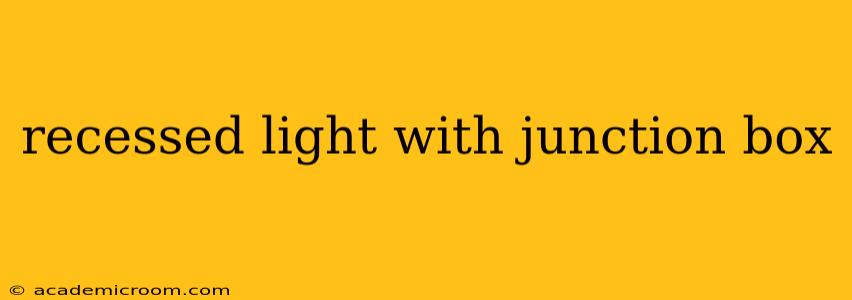Installing recessed lighting can dramatically improve your home's ambiance and functionality. However, understanding the role of junction boxes is crucial for a safe and effective installation. This comprehensive guide will delve into the intricacies of recessed lighting and junction boxes, answering your most pressing questions.
What is a Junction Box and Why is it Necessary for Recessed Lighting?
A junction box is an electrical enclosure that houses wire connections. In the context of recessed lighting, the junction box serves as a safe and organized point where the wiring from your home's electrical system connects to the wires leading to the recessed light fixture. Its primary purpose is safety—it protects the electrical connections from damage, moisture, and accidental contact. Without a junction box, exposed wiring poses a significant fire and shock hazard. The box also provides a secure mounting point for the light fixture, ensuring stability and preventing potential loose connections.
What Types of Junction Boxes are Used with Recessed Lighting?
Several types of junction boxes are suitable for recessed lighting installations, each with its own advantages and disadvantages:
-
Old Work Boxes: These are designed for installation in existing ceilings where there's no pre-existing opening. They require cutting a hole in the ceiling to accommodate the box and fixture. They often feature clamps or other mechanisms for securing the fixture.
-
New Work Boxes: These are typically installed during new construction or remodeling when the ceiling is open. They're often easier to install than old work boxes as they can be mounted before the ceiling is finished.
-
Remodel Boxes: These are a hybrid of old work and new work boxes, designed to simplify installation in existing ceilings without requiring extensive cutting. They often offer a simpler method of attaching the fixture.
-
IC-Rated Boxes: These boxes are specifically designed for use with insulation. Insulation can trap heat, potentially causing damage to non-IC rated boxes and even posing a fire hazard. IC-rated boxes allow for direct contact with insulation, ensuring safe and code-compliant installations. Always use IC-rated boxes if your recessed lights will be covered by insulation.
How Do I Choose the Right Size Junction Box for My Recessed Light?
The size of the junction box you need depends on the number and type of wires you’ll be connecting, as well as local electrical codes. These codes often specify minimum box volume requirements based on the number of conductors and the type of fixture. Always consult your local building codes and the instructions provided with your chosen light fixture and junction box. Undersized boxes are a fire hazard and can result in failed inspections.
Can I Use a Standard Junction Box for Recessed Lighting?
While some standard junction boxes might technically fit, it's crucial to ensure the box is rated for the specific application. Using a standard junction box designed for other applications is strongly discouraged and likely violates electrical codes. Recessed lighting involves specific requirements for secure mounting and heat dissipation, making specialized recessed lighting boxes necessary.
What are the Safety Precautions When Wiring Recessed Lights with Junction Boxes?
-
Turn off the power: Always switch off the power at the breaker box before beginning any electrical work.
-
Use the right tools: Employ appropriate tools like wire strippers, screwdrivers, and voltage testers to ensure a safe and efficient installation.
-
Follow local electrical codes: Always adhere to local building codes and regulations for electrical installations.
-
Use appropriate wire: The wire gauge must be adequate for the amperage of the light fixture.
-
Secure all connections: Ensure all wire connections are properly secured within the junction box. Loose connections are a fire hazard.
Are there different types of recessed light fixtures?
Yes, there are several types of recessed lighting fixtures available:
-
Standard Recessed Lights: These are the most common type, offering basic functionality and a range of finishes.
-
Trimmable Recessed Lights: These offer greater flexibility in customizing the look of your light, allowing for different trim styles.
-
Baffle Trim Recessed Lights: These incorporate a baffle, reducing glare and enhancing light diffusion.
-
Low-profile Recessed Lights: Designed for installation in shallow ceilings where standard recessed lighting might not fit.
This guide provides a foundational understanding of recessed lighting and the critical role junction boxes play. Remember, proper installation is key to ensuring both functionality and safety. Consult with a qualified electrician if you are unsure about any aspect of this process. Your safety is paramount.
